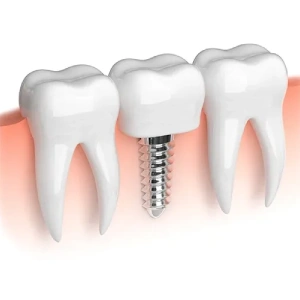Dental implants can be life-changing if you’ve lost a tooth or multiple teeth. They are a durable, natural-looking, and functional replacement for missing teeth. But before jumping into the procedure, it’s important to understand the stages of dental implants. Dental implants are a multi-step process that involves careful planning, surgery, and follow-up care to ensure a successful and lasting result.
Let’s discuss the 3 stages of dental implants, so you can better understand what to expect and how each stage contributes to restoring your smile.

What Are Dental Implants?
Before discussing the stages of dental implants, let’s first understand what they are. Dental implants are titanium posts surgically placed into the jawbone, replacing the roots of missing teeth. Once the implant has integrated with the jawbone, a custom-made crown is placed on top, providing a stable, functional, and aesthetically pleasing tooth replacement. The highly effective and long-lasting procedure makes dental implants a top choice for replacing missing teeth.
What Are The 3 Stages of Dental Implants?
The process of getting dental implants involves three distinct stages, each of which plays a crucial role in ensuring the long-term success of your implant. Here’s a closer look at each stage of dental implants:
Stage 1: The Consultation and Planning Stage
The first stage of dental implants involves an in-depth consultation with your dentist. This is a critical step where your dentist will assess your oral health, discuss your goals, and determine whether dental implants are the right solution. Here’s what happens during this stage:
1. Initial Consultation
During the consultation, your dentist will take X-rays and may perform a CT scan to evaluate the health of your jawbone and identify any existing dental issues. This helps your dentist determine the best course of action for your treatment.
2. Treatment Plan Development
Once the initial evaluation is complete, your dentist will create a customized treatment plan based on your needs. If your jaw has insufficient bone density, your dentist may recommend a bone graft before implant surgery.
3. Pre-Surgical Preparations
In some cases, any remaining teeth or damaged tissue in the area where the implant will be placed must be removed before surgery. Your dentist will also discuss the type of anesthesia to use, ensuring your comfort throughout the procedure.
Stage 2: The Implant Placement Surgery
Once the planning is complete, the next step in the stages of dental implants is the actual surgical procedure. Depending on the procedure’s complexity, this stage occurs in your dentist’s office or an oral surgery center.
1. Implant Placement
During the surgery, your dentist will make a small incision in the gum tissue to access the jawbone. The titanium implant is then carefully placed into the bone, serving as the root of your new tooth. The gum tissue is then sutured, and the implant is left to heal.
2. Healing Period
After the implant is placed, a process known as osseointegration begins. This is when the titanium implant fuses with the surrounding bone tissue. This fusion is critical for the implant’s stability, providing a solid foundation for the future crown. The healing process takes 3 to 6 months, depending on the individual and the location of the implant.
Stage 3: The Restoration Stage
The final stage of dental implants is when the implant is fully integrated into the jawbone, and the final restoration is placed. This is where you’ll see the results of all your hard work.
1. Abutment Placement
Once the implant has fused with the bone, your dentist will attach an abutment, a small connector to hold the crown in place. In some cases, the abutment may be placed during the same procedure as the implant placement, while in others, it may require a second minor surgery.
2. Custom Crown Fabrication
Next, your dentist will take impressions of your mouth to create a custom crown that will fit securely onto the abutment. The crown is designed to match the size, shape, and color of your surrounding teeth, ensuring a natural appearance.
3. Crown Placement
Once your custom crown is ready, it is placed onto the abutment and adjusted for fit, comfort, and bite. Your dentist will ensure the crown looks natural and functions like a real tooth. After a final adjustment, your dental implant is complete, and your new smile is ready to enjoy.
Why Choose Dental Implants?
Although the stages of dental implants require time and patience, the long-term benefits significantly outweigh any temporary discomfort. Here are five compelling reasons to choose dental implants over other tooth replacement options:
1. Longevity and Durability
With proper care, dental implants are designed to last a lifetime. Unlike dentures or bridges, which need to be replaced every few years, implants provide a permanent solution that offers long-term benefits, making them a cost-effective investment in oral health.
2. Improved Oral Function
Dental implants function just like natural teeth, allowing you to eat, speak, and smile confidently. They restore full functionality to your mouth, allowing you to enjoy your favorite foods without the discomfort or inconvenience of removable dentures or bridges.
3. Natural Appearance
One of the standout advantages of dental implants is their ability to seamlessly blend with your natural teeth. Custom-made crowns are carefully crafted to match the shape, size, and color of your existing teeth, ensuring a beautiful, natural-looking smile that enhances your overall appearance.
4. Preservation of Jawbone Health
Unlike other tooth replacements, dental implants help prevent bone loss by stimulating the jawbone, just like the roots of natural teeth. This helps maintain facial structure and prevents the sinking or shifting of the jawbone, which often occurs when teeth are missing.
5. Enhanced Comfort and Confidence
Since dental implants are securely anchored into the jaw, they offer comfort and stability that removable dentures or bridges cannot provide. You won’t need to worry about slippage or discomfort while speaking or eating, and the improved fit enhances your confidence in social and professional situations.
Takeaway on the Stages of Dental Implants
The stages of dental implants are designed to ensure a successful, long-lasting result. From the initial consultation and planning stage to the implant placement surgery and final restoration, each phase plays a critical role in restoring your smile’s appearance, function, and health. While the process takes time, the benefits of dental implants make it a worthwhile investment for many patients.
Ready to Transform Your Smile with Dental Implants?
If you’re considering dental implants and are ready to restore your smile, Centers for Dental Implants is here to help you understand all the stages of dental implants. Our experienced team specializes in providing safe, effective, and long-lasting dental implants.
Call or visit us in Aventura, Pembroke Pines, or Hallandale Beach, FL, to book your consultation today. Let us help you achieve the smile you’ve always dreamed of!
FAQs
How long is the time between stages of dental implants?
The time between the stages of dental implants ranges from 3 to 6 months. This period allows for osseointegration, where the implant fuses with the jawbone. The exact duration depends on individual healing rates and the complexity of the procedure.
How painful is the second stage of a dental implant?
The second stage of dental implants involves placing the abutment, which is generally not very painful. Local anesthesia is used, so you shouldn’t feel much discomfort. Some mild swelling or soreness may occur afterward, but it usually subsides within a few days with over-the-counter pain relief.
At what stage do dental implants fail?
Dental implants can fail at any stage, though it is most common during the osseointegration phase (the healing process after implant placement) if the implant doesn’t fuse properly with the bone. Factors such as infection, poor bone quality, or excessive movement can contribute to implant failure.

